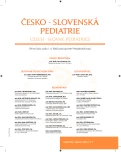The care of prematurely born child: when to begin and end?
Authors:
D. Marková 1; M. Weberová-Chvílová 1; P. Raušová 1; E. Knězů 1; P. Klement 1; B. Korsová 1; I. Příhodová 1; E. Koštálová 1; V. Kredba 1; Jakub Langer 1; P. Frühauf 1; J. Kytnarová 1; P. Koťátko 1; J. Šulc 1; L. Vepřeková 1; P. Uhlíková 1; P. Jánská 1; R. Vyhnánek 1; B. Zlatohlávková 2; A. Fleischnerová 1; R. Ptáček 1; D. Mirovská 1; L. Smolíková 1; E. Haškovcová 1; J. Mercelová 3; R. Kunzmanová 1; J. Zeman 1
Authors‘ workplace:
Klinika dětského a dorostového lékařství UK 1. LF a VFN, Centrum komplexní péče pro děti s perinatální zátěží, Prahapřednosta prof. MUD. J. Zeman, DrSc.
1; Neonatologické oddělení, Gynekologicko-porodnická klinika UK 1. LF a VFN, Prahaprimář prof. MUDr. R. Plavka, CSc.
2; Foniatrická klinika VFN, Prahapřednostka doc. MUDr. O. Dlouhá, CSc.
3
Published in:
Čes-slov Pediat 2014; 69 (1): 53-62.
Category:
Actual Topic
Overview
Over the last twenty years, neonatal mortality in the Czech Republic declined significantly to current 1.38 per 1 000 born alive. As a result, increasing number of babies surviving early neonatal period has been repeatedly reported. Despite significant improvement in neonatal intensive care, many babies are however suffering from serious perinatal morbidity, particularly those with extremely low birth weight.
The recent data show that out of 107 213 children born alive in the Czech Republic in 2012, 8 897 of them were reported preterm, which represent 8.3 %. As consequence, there is constantly increasing demand for further clinical investigation, treatment and long term follow up of these children. Centralised multidisciplinary collaborative approach developed in our unit may offer unique approach to improve long term outcome of these children. Further decline in morbidity translates into better socialisation and mitigates negative impact on entire family.
Historically, the outcome measures of success of treatment of prematurely born babies were mortality and short term morbidity. Nowadays, it becomes obvious that not only short term but particularly long term follow up provides optimal medical care to ex-preterm children and their families. Detailed long term observational studies provided by centralised approach on associated co-morbidity, future neurodevelopmental and psychosocial behaviour including education abilities will help better understand of natural history and may serve for future medical management and medical care planning in the Czech Republic and beyond.
Key words:
prematurity, low birth weight infant, long term morbidity, long term follow up, developmental disorders, multidisciplinary collaboration
Sources
1. Plavka R. Neonatální mortalita a morbidita. Česká republika 2012 – viz http://www.neonatology.cz.
2. Msall ME. Optimizing early development and understanding trajectories of resiliency after extreme prematurity. Pediatrics 2009; 124 : 387–390.
3. Gargus RA, Vohr BR, Tyson JE, et al. Unimpaired outcomes for extremely low birth weight infants at 18 to 22 months. Pediatrics 2009; 124 (1): 112–121.
4. Zoban P. Neuromotorická a senzorická morbidita děti s porodní hmotnosti do 1500g jako ukazatel kvality perinatální a neonatální peče. Čes-slov Pediat 2004; 59 (12): 610–614.
5. Moddemann D, Shea S. The developmental paediatrician and neonatal follow up. Paediatric Child Health 2006; 11 (5): 295–299.
6. Engle WA, Tomashek KM, Wallmann C. Late preterm infants: A population at risk. Pediatrics 2007; 120 (6): 1390–1401.
7. Morse SB, Sheng H, et al. Early school-age outcomes of late preterm infants. Pediatrics 2009; 123 : 622–629.
8. Hack M, et al. Behavioral outcomes of extremely low birth weight children at age 8 years. J Dev Behav Pediatr 2009; 30 (2): 122–130.
9. Sobotková D. Proč považujeme za důležité dlouhodobé psychologické sledování nedonošených dětí. XX. celostátní konference ošetřovatelských profesí v péči o novorozence, České Budějovice, 12. května 2011.
10. Arnoudse-Moens CS, Weisglas-Kuperus N, et al. Meta-analysis of neurobehavioral outcomes in very preterm and/or very low birth weight children. Pediatrics 2009; 124 : 717–728.
11. Johnson S, Hollis Ch, Marlow N. Autism spectrum disorders in extremely preterm children. J. Pediatr 2010; 156 : 525–531.
12. Saigal S, Hoult L, Streiner D, et al. School difficulties at adolescence in a regional cohort of children who were extremely low birth weight. Pediatrics 2000; 105 (2): 325–331.
13. Hack M. Adult outcomes of preterm children. J Dev Behav Pediatr 2009; 30 (5): 460–467.
14. Hack M, et al. Outcomes in young adulthood for very-low-birth-weight infants. N Engl J Med 2002; 346 (3): 149–156.
15. Saigal S, Stoskopf B, Boyle M, et al. Comparison of current health, functional limitations, and health care use of young adults who were born with extremely low birth weight and normal weight. J. Pediatrics 2007; 119 : 562–573.
16. Zwicker JG, Harris SR. Quality of life of formerly preterm and very low birth weight infants from preschool age to adulthood: a systematic review. Pediatrics 2008; 121 : 366–376.
17. Usnesení vlády č. 1046/2002 – viz http://www.mzcr.cz/data/c564/lib/UV_1046.rtf.
18. Zdraví pro všechny ve 21. století – viz http://www.mzcr.cz/index.php.kategorie=211.
19. Usnesení vlády č. 1046/2002 – Cíl 3 „Zdravý start do života“, dílčí úkol 3.2.1 Snížit prevalenci pozdní (postneonatální) morbidity, viz http://www.mzcr.cz/data/c564/lib/zdravi_21_cil_1_9.rtf.
20. Usnesení vlády č. 1046/2002 – Cíl 3 „Zdravý start do života“, dílčí úkol 3.2.2 Vytvořit standardizovaný systém integrované ranné péče o perinatálně ohrožené a postižené děti na regionální úrovni a to na základě vytvoření příslušného legislativního návrhu, http://www.mzcr.cz/data/c564/lib/zdravi_21_cil_1_9.rtf.
Labels
Neonatology Paediatrics General practitioner for children and adolescentsArticle was published in
Czech-Slovak Pediatrics

2014 Issue 1
Most read in this issue
- Cryptorchidism – the need of early diagnostics and treatment
- Transient pseudohypoaldosteronism – „puzzle“ of pediatric nephrology and urology
- The care of prematurely born child: when to begin and end?
- Adipsic diabetes insipidus in a child with dysgenesis of corpus callosum
